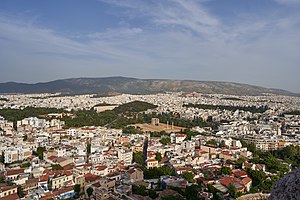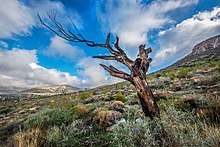Hymettus
Hymettus (/haɪˈmɛtəs/), also Hymettos (/haɪˈmɛtɒs/; Greek: Υμηττός, transliterated Ymīttós, pronounced [imiˈtos]), is a mountain range in the Athens area of Attica, East Central Greece.[1] It is also colloquially known as Trellós (crazy) or Trellóvouno (crazy mountain); the latter originates from the French "très long" (very long) in awe of its winding length of 16km, as used by French travelers during the occupation of Greece by the Ottomans. In antiquity there was a sanctuary to Zeus Ombrios (Zeus the Rain God) on the summit with numerous offerings dating especially to the 8th-7th centuries BC; they are on the site of a military base and not currently accessible. There is also an ancient quarryman's hut on the western slopes of the mountain, one of two buildings in ancient Attica which preserves its roof.
| Hymettus | |
|---|---|
 View of Hymettus from Acropolis | |
| Highest point | |
| Elevation | 1,026 m (3,366 ft) |
| Coordinates | 37.963°N 23.81667°E |
| Geography | |
| Location | East-central Attica about 15 km E of central Athens |
| Parent range | Hymettus |
| Climbing | |
| Easiest route | climb, road |
The height is 1,026 m (3,366 ft)[2] at Evzonas and the length is 16 km (9.9 mi) between Athens and the Saronic Gulf and 6 to 7 km from east to west. In the ancient times, the highest point was known as Mega Ymittos and the southern Elattona (Ελάττονα) and Anydro Ymitto (Άνυδρο Υμηττό) (today Mavrovouni (Μαυροβούνι meaning black mountain) and Kontra (Κόντρα). It was noted for its thyme honey.[1] Marble has been quarried since antiquity.[1] The neighboring communities that surround the mountain are Athens (municipality), Zografou, Kaisariani, Vyronas, Ilissia (a region of Zografou), Ymittos, Ilioupoli, Argyroupoli, Elliniko, Glyfada, Voula and Vouliagmeni in the west, Varkiza, Vari, Markopoulo and Paiania to its east, and Papagou, Cholargos, Agia Paraskevi, Gerakas and Glyka Nera. Most of the forest is in the north, and much of the mountain is rocky, deforested, grassy and made out of limestone.

Major campuses of the University of Athens and the National Technical University of Athens (collectively called "University Town") are located on the west-facing slope, between the Motorway 64, a ring road connected with the Motorway 6, and the urban sprawl of Athens. A transmitter park for several major TV and radio stations, along with military radar is located at the top of the mountain. Built up urban areas almost surround the entire mountain range. Access to the top of the mountain is restricted to authorized vehicles for maintenance of the towers.
Almost all of Athens, its eastern suburbs and the new airport can be seen from the mountain top along with the mountains of Parnitha to its northwest, Penteli to its north and Aegaleo to its west. The valley areas that create the lowest passes are to the south and one further south.
The mountain ranges features about six to seven landfills in the western part and another in the eastern part.
References
- Chisholm, Hugh, ed. (1911). . Encyclopædia Britannica. 14 (11th ed.). Cambridge University Press. p. 181.
- "Mount Hymettus". britannica.com.